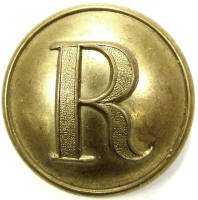
A virtual examination of artifacts of the American Civil War
 |
Ridgeway Civil War Research Center, A virtual examination of artifacts of the American Civil War |
| Civil War Artillery | |
| by Harry Ridgeway |
| Rifled artillery projectile, Tennessee design, Confederate manufacture, bursting shell, pattern with, rounded nose smooth sides, copper disc sabot with 3 studs in the shell and flush mounted bolt, wood time fuze, Blakeley 12 pounder rifle, 3.5in. Projectile was Confederate manufactured and was originally believed to have been developed by Mullane working with Read and others, however, updated research has not been able to confirm the existence of a man named Mullane. Period literature often refers to work as the "Tennessee" design, cup, or sabot, and is attributed to Captain Lardner Gibbon, although official recognition for his development was never granted. The sabot system utilized was a copper disc held in place by studs and secured with a center bolt, a manufacturing innovation allowing the parts made of different metals, copper and iron, to be prepared independent and assembled at the end. This sabot pattern, referred to as Type I, employed three long studs cast into the shell body fitted through the disc sabot, a short bolt secured the copper disc flush mounted. Performance of this sabot was unsatisfactory, typically the studs or the bolt would break on firing releasing or distorting the copper disc sabot. Sides are smooth. Fuze employed was a wood time fuze, fuze hole is smooth and tapered, the simple to make fuze could easily be hammered into place, Jones Fuzes pg. 2. Projectile measures: diameter 3.4in., length 6.5in. shell body, 7.25 overall weight 11.0lbs. Research Center: Artillery5831-Tennessee, Ref: Dickey & George, Field Artillery (1993 Edition), pg. 211. Details click: http://relicman.com/artillery/Artillery5831-Tennessee.html. |
| Ridgeway Civil War Research Center, A virtual examination of artifacts of the American Civil War. Artillery Research center, artillery, click: http://relicman.com/artillery/Artillery0000-Index.html. Research center, artillery, click: http://relicman.com/artillery/Artillery0000-Index.html. |
| Civil War Relicman, Harry Ridgeway, Civil War artillery, Relicman sales catalog. Click here: http://relicman.com/artillery/RelicmanSalesArtillery1.html. Artillery for sale: http://relicman.com/artillery/RelicmanSalesArtillery1.html. |